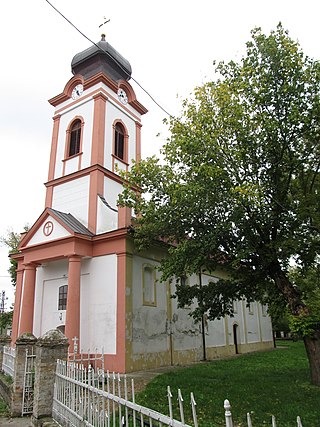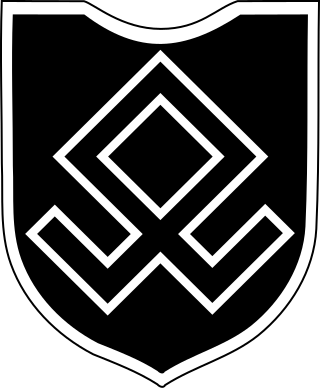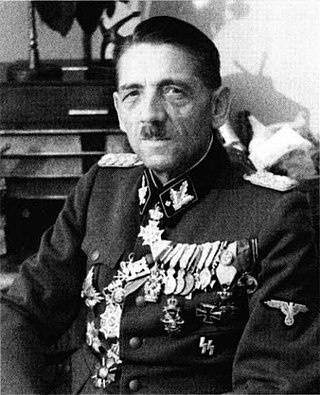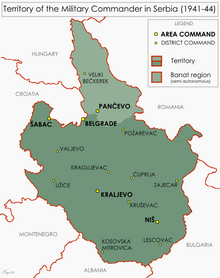
Vojvodina, officially the Autonomous Province of Vojvodina, is an autonomous province that occupies the northernmost part of Serbia, located in Central Europe. It lies within the Pannonian Basin, bordered to the south by the national capital Belgrade and the Sava and Danube Rivers. The administrative center, Novi Sad, is the second-largest city in Serbia.

Srpska Crnja is a village in Serbia, situated in central-east Banat alongside the border with Romania. It is located in Nova Crnja municipality, Central Banat District, Province of Vojvodina. It is about 120 km away from the capital city of Belgrade, 113 km from Novi Sad, 9 km south-east of Kikinda and 6 km south-west of Jimbolia, Romania. The village has a population of 3753 people and most of its inhabitants are ethnic Serbs (83.77%).

Vojvodina is a province in Republic of Serbia and one of the most ethnically diverse regions in Europe, home to 25 different ethnicities.

The Danube Swabians is a collective term for the ethnic German-speaking population who lived in various countries of central-eastern Europe, especially in the Danube River valley, first in the 12th century, and in greater numbers in the 17th and 18th centuries. Most were descended from earlier 18th-century Swabian settlers from Upper Swabia, the Swabian Jura, northern Lake Constance, the upper Danube, the Swabian-Franconian Forest, the Southern Black Forest and the Principality of Fürstenberg, followed by Hessians, Bavarians, Franconians and Lorrainers recruited by Austria to repopulate the area and restore agriculture after the expulsion of the Ottoman Empire. They were able to keep their language and religion and initially developed strongly German communities in the region with German folklore.

The 7th SS Volunteer Mountain Division "Prinz Eugen", initially named the SS-Volunteer Division Prinz Eugen, was a mountain infantry division of the Waffen-SS, an armed branch of the German Nazi Party that served alongside but was never formally part of the Wehrmacht during World War II. At the post-war Nuremberg trials, the Waffen-SS was declared to be a criminal organisation due to its major involvement in war crimes and crimes against humanity. From 1942 to 1945, the division fought a counter-insurgency campaign against communist-led Yugoslav Partisan resistance forces in occupied Yugoslavia. It was formed in 1941 from both Reich Germans and Volksdeutsche – ethnic German volunteers and conscripts from the Banat, Independent State of Croatia, Hungary and Romania. The division surrendered on 11 May 1945 to Yugoslav Partisan forces.
Banatsko Novo Selo is a village located in the municipality of Pančevo, South Banat District, Vojvodina, Serbia. The village has a Serb ethnic majority and its population numbering 7,089 people.
Vojvodina is an autonomous province located in northern Serbia. It consists of the Pannonian Plain in the south, and the Danube and Sava rivers in the north.

The Banat Swabians are an ethnic German population in the former Kingdom of Hungary in Central-Southeast Europe, part of the Danube Swabians and Germans of Romania. They emigrated in the 18th century to what was then the Austrian Empire's Banat of Temeswar province, later included in the Habsburg Kingdom of Hungary, a province which had been left sparsely populated by the wars with the Ottoman Empire. At the end of World War I in 1918, the Swabian minority worked to establish an independent multi-ethnic Banat Republic; however, the province was divided by the Treaty of Versailles of 1919, and the Treaty of Trianon of 1920. The greater part was annexed by Romania, a smaller part by the Kingdom of Serbs, Croats and Slovenes and a small region around Szeged remained part of Hungary.

Veliki Gaj is a village located in the Plandište municipality, in the South Banat District of Serbia. It is situated in the Autonomous Province of Vojvodina. According to the 2002 census, the population of the village was 790 people, of whom 670 were ethnic Serbs (84.81%).

Artur Gustav Martin Phleps was an Austro-Hungarian, Romanian and German army officer who held the rank of SS-Obergruppenführer und General der Waffen-SS in the Waffen-SS during World War II. At the post-war Nuremberg trials, the Waffen-SS – of which Phleps was a senior officer – was declared to be a criminal organisation due to its major involvement in war crimes and crimes against humanity. An Austro-Hungarian Army officer before and during World War I, Phleps specialised in mountain warfare and logistics, and had been promoted to Oberstleutnant by the end of the war. During the interwar period he joined the Romanian Army, reaching the rank of General-locotenent, and also became an adviser to King Carol. After he spoke out against the government, he asked to be dismissed from the army after being sidelined.


The Germans of Yugoslavia is a term for German-speakers who form a minority group in former Yugoslavia, namely Croatia, Serbia, Bosnia and Herzegovina or Slovenia. Despite the name for the group, the label includes ethnic Germans, primarily Danube Swabians, and Austrians. The largest German minority was found in Serbia prior to dissolution of Yugoslavia.
The communist purges in Serbia in 1944–1945 are atrocities that were committed by members of the Yugoslav Partisan Movement and the post-war communist authorities after they gained control over Serbia, against people perceived as war criminals, quislings and ideological opponents. Most of these purges were committed between October 1944 and May 1945. During this time, at least 55,973 people died of various causes, including death by execution or by illness in retention camps. The victims – the vast majority of them deliberately summarily executed, without a trial – were of different ethnic backgrounds, but were mostly Germans, Serbs and Hungarians. Some contend that the killings were not planned, but were unorganised vendettas of individuals during the post-war chaos, or that those considered victims of execution instead died in battle against the Partisans.

The military occupation of the Yugoslav region of Vojvodina from 1941 to 1944 was carried out by Nazi Germany and its client states / puppet regimes: Horthy's Hungary and Independent State of Croatia.

Glogonj is a village in Serbia, situated in the South Banat District of the province of Vojvodina. It is located on the banks of the Tamiš River, about 20 kilometers northwest of Pančevo, and about 20 kilometers direct north of Belgrade. It has a Serb ethnic majority, numbering 2,657 people as of 2022. Its neighboring villages are Sefkerin to the north and Jabuka to the south. All of them lie on the Tamiš.

The Germans of Serbia are an ethnic minority of Serbia which numbers 2,573 people according to the last population census from 2022. The Germans of Serbia usually refer to themselves as Swabian, and they are grouped into the Danube Swabians or Banat Swabians in the Vojvodina region, where the majority of the population resides. Germans settled parts of Serbia in the late 17th century during Habsburg administration. The German population of Vojvodina was more numerous in the past.

The Holocaust in German-occupied Serbia was part of the European-wide Holocaust, the Nazi genocide against Jews during World War II, which occurred in the Territory of the Military Commander in Serbia, the military administration of the Third Reich established after the April 1941 invasion of Yugoslavia. The crimes were primarily committed by the German occupation authorities who implemented Nazi racial policies, assisted by the collaborationist forces of the successive puppet governments established by the Germans in the occupied territory.

During World War II, the Kingdom of Hungary engaged in the military occupation, then annexation, of the Bačka, Baranja, Međimurje and Prekmurje regions of the Kingdom of Yugoslavia. These territories had all been under Hungarian rule prior to 1920, and had been transferred to Yugoslavia as part of the post-World War I Treaty of Trianon. They now form part of several states: Yugoslav Bačka is now part of Vojvodina, an autonomous province of Serbia, Yugoslav Baranja and Međimurje are part of modern-day Croatia, and Yugoslav Prekmurje is part of modern-day Slovenia. The occupation began on 11 April 1941 when 80,000 Hungarian troops crossed the Yugoslav border in support of the German-led Axis invasion of Yugoslavia that had commenced five days earlier. There was some resistance to the Hungarian forces from Serb Chetnik irregulars, but the defences of the Royal Yugoslav Army had collapsed by this time. The Hungarian forces were indirectly aided by the local Volksdeutsche, the German minority, which had formed a militia and disarmed around 90,000 Yugoslav troops. Despite only sporadic resistance, Hungarian troops killed many civilians during these initial operations, including some Volksdeutsche. The government of the newly formed Axis puppet state, the Independent State of Croatia, subsequently consented to the Hungarian annexation of the Međimurje area, which dismayed the Croat population of the region.

During World War II, several provinces of the Kingdom of Yugoslavia corresponding to the modern-day state of Serbia were occupied by the Axis Powers from 1941 to 1944. Most of the area was occupied by the Wehrmacht and was organized as separate territory under control of the German Military Administration in Serbia. Other parts of modern Serbia that were not included in the German-administered territory were occupied and annexed by neighboring Axis countries: Syrmia was occupied and annexed by the Independent State of Croatia, Bačka was occupied and annexed by Hungary, southeastern Serbia was occupied and annexed by Bulgaria, and southwestern Serbia was occupied and annexed by Italy and included in the Italian protectorates of Albania and Montenegro.


















